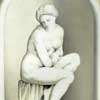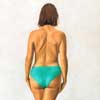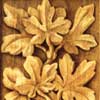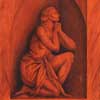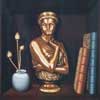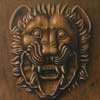trompe l'oeil paintings
Trompe l'oeil, literally meaning to trick or deceive the eye
This is a style of painting which plays a knowing game with the viewer, the objective of which is to fool us into perceiving something as apparent, real and three dimensional when it is in fact painted and two dimensional. The trompe l'oeil artist's endeavor is therefore very demanding and requires a rigourous and disciplined approach.
click for large trompe l'oeil paintings images
trompe-l'oeil paintings and illusionistic art
In general the trompe l'oeil idiom is considered to be a form of, and a subclass of Illusionistic art and executed somewhat in the manner of Super Realism.
Trompe- l'oeil paintings seemingly exert an inextinguishable fascination upon the human mind. Whilst this genre of illusionistic painting flits in and out of popularity and fashion it almost inevitably evokes appreciation from the viewer. It is likely that the art form strikes the same chord as that experienced by us as infants when the game of 'peek a boo' was played. So we delight in the joke resultant upon realizing that the world really was not as we assumed it to be, and that everything is okay after all, we were playfully deceived, mother didn't really disappear. It is thus perhaps that one of the psychological origins of the sense of humor are played upon in the art form. The ludic and humourous are therefore almost by definition a strong element if not a necessary a characteristic of this genre.
History of trompe l'oeil painting
The history of this deceptive art form goes right back to the Late Antique Period at Pompeii and similar sites. There is the apocryphal description by Pliny the Elder of the competition between the artist Zeuxis and his rival Parrhasius. The grapes that Zeuxis painted attracted birds which tried to peck at them. Zeuxis was then trumped by Parrhasius when Zeuxis asked him to move aside a curtain so he could see his painting only to discover the curtain to be painted. Another famous trompe l'oeil artists story is that of Giotto (1266-1337) fooling his master Cimabue (1240-1302?) into attempting to waft away a fly he had realistically painted on to a surface.
Probably the earliest surviving example of the form as we interpret it today, is Jacop de Barbari's still life of 1504 entitled: 'Partridge, Iron Gloves and Crossbow Bolt'. A good century later we then have the illusionistic cupboard painted by Georg Flegel (circa 1610) One of the first Post-Antique examples of the mural form is the Camera delgi Sposi at Mantua painted by Mantegna and completed in1474. The idiom then went on to reach something of a Zenith with the Italian Baroque.
All of these examples are non usual for their time and have to be regarded as the planted seeds, from which further developments grew. Easel trompe-l'oeil as a well defined genre primarily emerged in Holland in the 1650's with Carel Fabritius and Samuel van Hoogstraten. Various specializations then occur such as the letter rack, dead birds on a wooden panel, and so on. A few decades later we have the flowering of the likes of Cornelius Gijsbrechts working in the Danish Court and Edward (Evert) Collier (1662-1708).
More recently in the latter part of the nineteenth century and early twentieth century a revival of the form occurred in America with artists like William Harnett (1848-1892) John F. Peto (1854-1907) and John Haberle ( 1856-1933) amongst others.
trompe loeil paintings: achieving the look
In order to achieve the objectives of the trompe l'oeil painting game, certain ground rules become evident. These are; that all the elements are life size, no elements are cut off by a real frame, invisibility of painting process, avoidance of live figures likely to move, and a shallow perspective enabling viewing from multiple view points. I am indebted for this analysis to Miriam Milman. These rules of the game alter in some respects with trompe l'oeil murals and painted architectural deceptions or quadrature.


